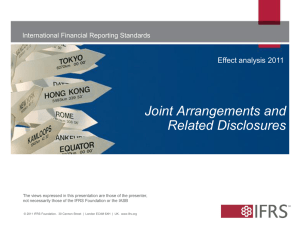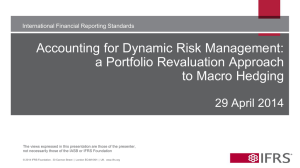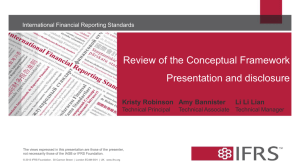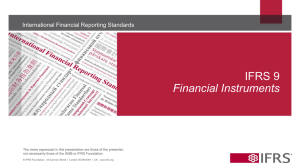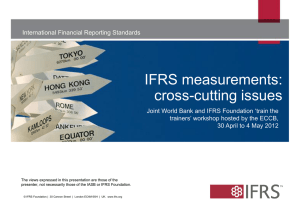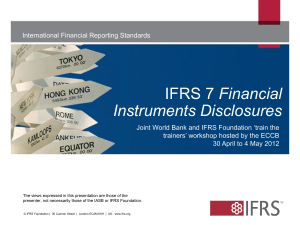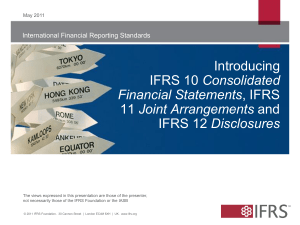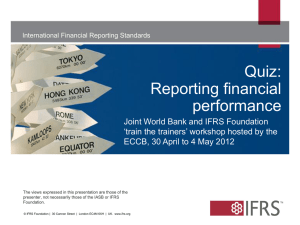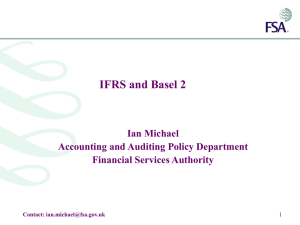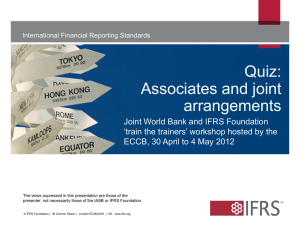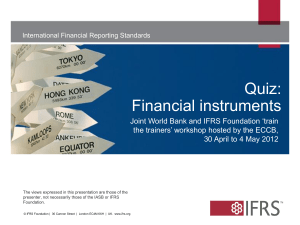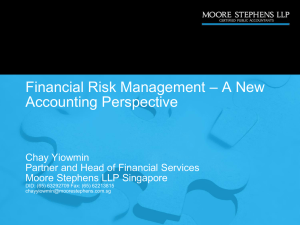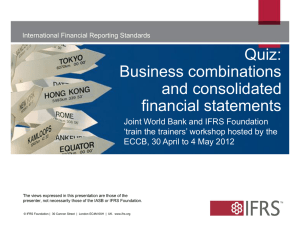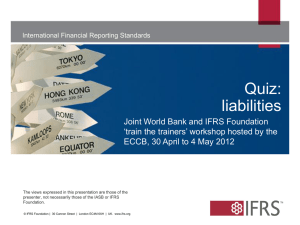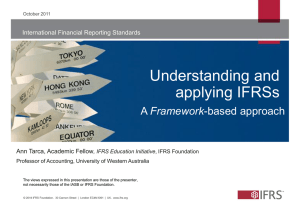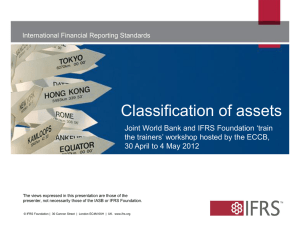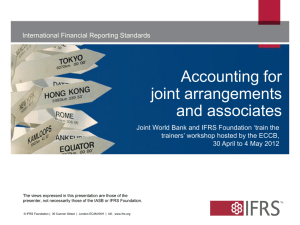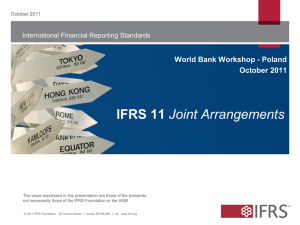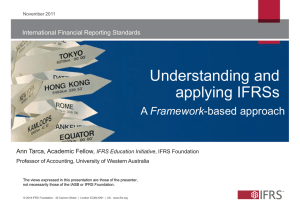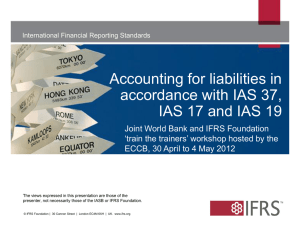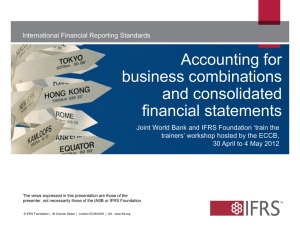Quiz: Assets: fair value measurement
advertisement
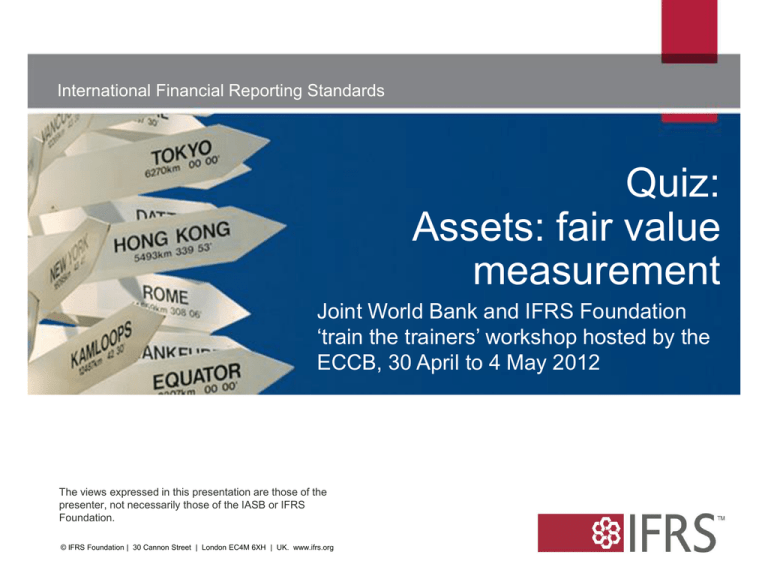
International Financial Reporting Standards Quiz: Assets: fair value measurement Joint World Bank and IFRS Foundation ‘train the trainers’ workshop hosted by the ECCB, 30 April to 4 May 2012 The views expressed in this presentation are those of the The views expressed in this presentation areor those presenter, not necessarily those of the IASB IFRSof the presenter, Foundation. not necessarily those of the IASB or IFRS Foundation. © IFRS Foundation | 30 Cannon Street | London EC4M 6XH | UK. www.ifrs.org Quiz: Assets fair value measurement 2 Question 1: Which of the following is NOT relevant when measuring the fair value of an asset? a. Whether the asset is sold in an orderly transaction b. The intention of an entity for holding an asset c. The measurement date/current price of the asset d. Whether the sale occurred between market participants e. None of the above © IFRS Foundation | 30 Cannon Street | London EC4M 6XH | UK | www.ifrs.org Quiz: Assets fair value measurement 3 Question 1: Which of the following is NOT relevant when measuring the fair value of an asset? a. Whether the asset is sold in an orderly transaction b. The intention of an entity for holding an asset c. The measurement date/current price of the asset d. Whether the sale occurred between market participants e. None of the above © IFRS Foundation | 30 Cannon Street | London EC4M 6XH | UK | www.ifrs.org Quiz: Assets fair value measurement 4 Question 2: Which of the following are examples of transaction costs in accordance with IFRS 13? a. transport costs b. transfer duty c. finance costs © IFRS Foundation | 30 Cannon Street | London EC4M 6XH | UK | www.ifrs.org Quiz: Assets fair value measurement 5 Question 2: Which of the following are examples of transaction costs in accordance with IFRS 13? a. transport costs b. transfer duty c. finance costs © IFRS Foundation | 30 Cannon Street | London EC4M 6XH | UK | www.ifrs.org Quiz: Assets fair value measurement 6 Question 3: In measuring the price (or fair value) in an orderly transaction, how should an entity account for transaction costs? a. adjust fair value for transaction costs b. ignore transaction costs when measuring fair value c. the decision is asset-specific © IFRS Foundation | 30 Cannon Street | London EC4M 6XH | UK | www.ifrs.org Quiz: Assets fair value measurement 7 Question 3: In measuring the price (or fair value) in an orderly transaction, how should an entity account for transaction costs? a. adjust fair value for transaction costs b. ignore transaction costs when measuring fair value c. the decision is asset-specific © IFRS Foundation | 30 Cannon Street | London EC4M 6XH | UK | www.ifrs.org Quiz: Assets fair value measurement 8 Question 4: When measuring the fair value of a non-financial asset, reference must be made to the highest and best use of the asset. Which of the following statements are true about the highest and best use of the asset? a. the use must be physically possible, legally permissible and financially feasible b. the highest and best use is determined from the perspective of market participants, only if the entity intends to use the asset in its operations c. the highest and best use is determined from the perspective of market participants, regardless of whether the entity intends to use the asset d. a. and c. © IFRS Foundation | 30 Cannon Street | London EC4M 6XH | UK | www.ifrs.org Quiz: Assets fair value measurement 9 Question 4: When measuring the fair value of a non-financial asset, reference must be made to the highest and best use of the asset. Which of the following statements are true about the highest and best use of the asset? a. the use must be physically possible, legally permissible and financially feasible b. the highest and best use is determined from the perspective of market participants, only if the entity intends to use the asset in its operations c. the highest and best use is determined from the perspective of market participants, regardless of whether the entity intends to use the asset d. a. and c. © IFRS Foundation | 30 Cannon Street | London EC4M 6XH | UK | www.ifrs.org Quiz: Assets fair value measurement 10 • Question 5: The assessment of the fair value of an entity’s financial instruments includes observable market information for a similar instrument and our own assumptions. In what level would this be categorised? a. Level 1 b. Level 2 c. Level 3 © IFRS Foundation | 30 Cannon Street | London EC4M 6XH | UK | www.ifrs.org Quiz: Assets fair value measurement 11 • Question 5: In what level would this be categorised? a. Level 1 b. Level 2 OR c. Level 3 If the valuation technique uses inputs from multiple levels of the fair value hierarchy, the lowest level of significant input determines the level of the entire fair value measurement in the hierarchy. The appropriate level depends on the significance to the overall measurement of the company’s own assumptions. © IFRS Foundation | 30 Cannon Street | London EC4M 6XH | UK | www.ifrs.org Quiz: Assets fair value measurement 12 • Question 6: How would you categorise the following? Unit 1: Unit 2: A unit in an investment fund is quoted in an active market. However the underlying investments are in unquoted equities that would be categorised within Level 3 in the fair value hierarchy. A unit in a non-quoted investment fund which only invests in financial assets quoted in active markets. No adjustments are made to the quoted prices when arriving at the value of the fund. A. B. C. D. Unit 1 Level 1 Level 1 Level 2 Level 3 Unit 2 Level 1 Level 2 Level 1 Level 2 © IFRS Foundation | 30 Cannon Street | London EC4M 6XH | UK | www.ifrs.org Quiz: Assets fair value measurement 13 • Question 6: How would you categorise the following? b. Level 1 and Level 2 Unit 1: Unit 2: • Level 1. • Level 2. • This is because the fund’s units are quoted in an active market. • Although the fund’s investments are quoted, the fund’s own units are not. © IFRS Foundation | 30 Cannon Street | London EC4M 6XH | UK | www.ifrs.org Quiz: Assets fair value measurement 14 Question 7 A building is used as a factory but is in a newly residential area. Other industrial and commercial buildings have been converted into residential use in the area. Based on expected future cash flows from use as a factory, the entity estimates a value of CU20m. However, the building could be sold for conversion to residential property for CU21m, incurring transaction costs of CU1.5m (surveys, fees etc). Prior to sale, the building would require repairs costing CU500k to return site to safe for human dwelling. What is the Fair Value of the building? a. b. c. d. CU19m CU19.5m CU20.5m CU21m © IFRS 2011 IFRS Foundation Foundation. | 30 Cannon 30 Cannon StreetStreet | London | London EC4M EC4M 6XH 6XH | UK.| www.ifrs.org UK. www.ifrs.org Quiz: Assets fair value measurement 15 Question 7 c. CU20.5m • “Highest and Best Use” is the highest value achieved through either current or alternative use. • The value is calculated net of repair cost but not transaction costs. © IFRS 2011 IFRS Foundation Foundation. | 30 Cannon 30 Cannon StreetStreet | London | London EC4M EC4M 6XH 6XH | UK.| www.ifrs.org UK. www.ifrs.org Questions or comments? Expressions of individual views by members of the IASB and its staff are encouraged. The views expressed in this presentation are those of the presenter. Official positions of the IASB on accounting matters are determined only after extensive due process and deliberation. © IFRS Foundation | 30 Cannon Street | London EC4M 6XH | UK | www.ifrs.org 16 17 The requirements are set out in International Financial Reporting Standards (IFRSs), as issued by the IASB at 1 January 2012 with an effective date after 1 January 2012 but not the IFRSs they will replace. The IFRS Foundation, the authors, the presenters and the publishers do not accept responsibility for loss caused to any person who acts or refrains from acting in reliance on the material in this PowerPoint presentation, whether such loss is caused by negligence or otherwise. © IFRS Foundation | 30 Cannon Street | London EC4M 6XH | UK | www.ifrs.org
